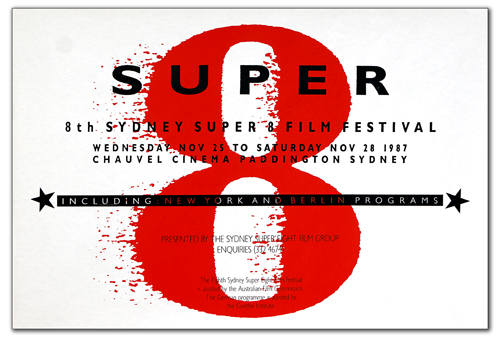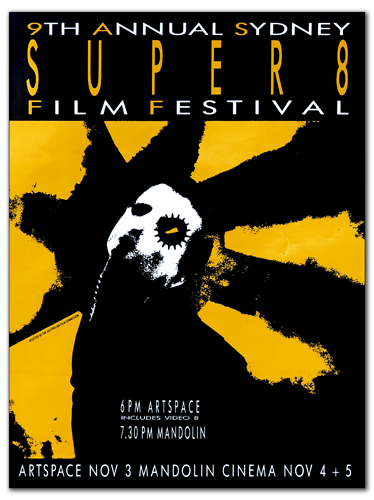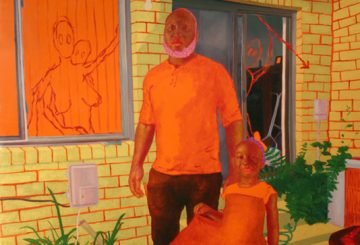Andrew Frost remembers the colours of the past, the Super Eighties and the things that happened…
I remember colours. There was the orange cast of Kodachrome 40, Ektachrome 180 blue, and the Japanese-green of Fujichrome. This was the raw stuff of Super 8, a home movie technology that had been invented in the mid-1960s. The poor cousin of the grown-up gauges of 16mm documentaries, avant-garde shorts and low-budget features – and the astronomically expensive world of pro 35mm productions – Super 8 was aimed squarely at the amateur. But in the DIY spirit of the ’70s and ’80s, this widely available and relatively cheap technology prompted a boom in the making of ultra-low budget but ambitious filmmaking. And with that boom there was a rapid increase in the number of screenings of the films, from cinemas and art galleries to clubs and warehouses.
The Third Sydney Super 8 Film Festival screened a short film about ballooning. I remember the balloons going up, gas burners under colourful striped fabrics, the granular blue of the sky, the balloons flying around, and then descending to green fields. I can’t remember what that film was called, who had made it, or whether there was a soundtrack or narration, or anything else. Consulting the archive of dLux.org I can’t find any record of it. Yet those balloons remain in my memory, phantom images from those three evenings at the Chauvel Cinema back in November 1982.
The First and Second Super 8 Film Festivals (S8FFs) had been organised by artist-film-maker Kate Richards in 1980 and 1981. Staged as all-night screenings at the Sydney Film Makers Co-Op (a 100-seat cinema in St Peters Lane, Darlinghurst), these were come-one-come-all events where the inner-city scene of squatters, students, artists and bohemians could bring their films and have them shown, from punk agitprop to Holocaust denial screeds, to would-be Nouvelle Vague romances and found-footage loops. Everything was permitted, and everything was shown.
The Sydney Super 8 Film Collective, a transitional group that included Deirdre Beck, Janet Burchill, Mark Titmarsh, Lindy Lee and Ross Gibson, had organised the 1982 festival. It was a very different kind of event to the earlier festivals: there were sessions, a bar, a program booklet, and it was ticketed – all very civilised. There was an announcement before one of the screenings that anyone interested in getting involved in the collective should come to an informal meeting in the cinema foyer. I was keen. I owned a Super 8 camera and I wanted to make more movies. My friends Sean O’Brien and Nick Meyers, who I’d met a few years before at a workshop for teenage filmmakers, came along too, as did a bunch of other people.
From that meeting the Sydney Super 8 Film Group (SS8FG) was born, a loose organisation of filmmakers and artists who, through the rest of that decade, would go on to stage annual festivals and bi-monthly late-night screenings, produce publications, tour programs around the country and overseas, and agitate for – and eventually receive from the Australian Film Commission – funding to set up an office, to purchase a pool of equipment, to pay a part-time salary. That group – which included myself, Titmarsh, Gary Warner, Michael Hutak, Catherine Lowing and Virginia Hilyard – would eventually evolve under new management into the Sydney Intermedia Network and then, eventually, into dLux Media Arts.
The confluence of cultural forces of that time weren’t unique to Sydney. In Brisbane and Melbourne, and in other cities around the world, university cinema studies courses, film clubs, repertory cinemas, and critical magazines and publications all conspired to produce a grassroots filmmaking scene that produced thousands of short films. The Third SS8FF was notable for the number of films that had been made in Melbourne: Philip Brophy’s The 1980 Moscow Olympics as Televised by HSV Channel 7 (made under the group name Tsk Tsk Tsk); Rolando Caputo’s Warhol’s 12 Most Beautiful Unseen Women;and Jane Stevenson’s Italian Boys – brainy, hip and stylish amalgams of post-punk glamour and early poststructuralist theory. Up against those films were movies like Titmarsh’s Forbidden Planet (an Alexander Kluge-like remake of the sci-fi classic with non-actors doing lines and scenes from the film intercut with appropriated sequences from the title movie; Stephen Harrop’s early found footage classics Square Bashing and Hoard – brilliantly executed collages of sound and image snippets; and of course, that movie about balloons.
The vibe of the time was eclectic – not quite the militant, right-on politics of the ’70s, not yet the hedonistic excess of post-modernity. The Sydney Super 8 Film Collective was rechristened the ‘Group’, in part because we wanted to avoid the implications of the term ‘collective’ and acknowledge that we had no explicit political agenda or allegiance, but also because ‘collective’ just sounded so daggy. Those kinds of questions were important in a way that seems utterly ridiculous now, but they were a measure of the time. Another characteristic of the SS8FG and its membership was its mixture of filmmakers and artists. There was no real separation between who made what – we all went to the gallery openings and the screenings, art magazines ran sections on film, and filmmakers read up on their philosophers.The Sydney Filmmakers Co-Op, which had been established in 1970 and was home to a number of experimental filmmakers and artists including Aggie Read, Albie Thoms and David Perry, had pioneered the marriage of artforms and practices. But although these kindred spirits were still going strong in the early 1980s, the Co-Op was regarded as reactionary in the revisionist spirit of the day – and the SS8FG worked hard to distance itself from the old folks and proclaim its specialness. I remember one screening staged at a Sydney Film Festival panel in the mid-’80s. With a few articles on the Super 8 scene appearing in the broadsheet magazine Filmnews [1], the audience was a mix of young filmmakers and a few older people who’d turned up to see what all the fuss was about. During the panel discussion after the screening, one young filmmaker announced without embarrassment that, in her opinion, Super 8 represented a brand-new way of documenting performance art. The groans of exasperation by those more experienced filmmakers and artists in the audience was deafening: all that had been going on since at least the 1940s. Such arrogant ignorance – could we have ever been so young?
There was also a critical engagement with the Super 8 scene. Writers such as Adrian Martin, Edward Colless and Rex Butler – along with articles by Titmarsh, Hutak and my own occasional contributions – helped create a discourse around what was called ‘the Super 8 effect’ – that conceptual leap between the very-real physical limitations of the medium and the almost limitless possibilities of the imaginations of the makers and their audience. The Super 8 films we were showing may have been shot and edited in rudimentary fashion, and scratched to hell as they spooled their way through the projectors, but they were something more – a moment of the Zeitgeist.
And that Zeitgeist sure was fun when you felt that you some hand in making it. The social aspect of the scene was incredibly important: you’d go to a screening and then spend hours at a bar or a friend’s warehouse discussing the importance, or lack thereof, of various films, encouraging your friends, dismissing the fakers. A Melbourne Super 8 Film Group appeared in 1985 and a somewhat strained relationship between the two groups began. Just as the SS8FG had attempted to distance itself from the Co-Op, so too the Melbourne crew wanted to be seen as different, and articles and opinion pieces began to appear in the pages of Filmnews in which the SS8FG were denounced as dilettante scenesters. The turf war that developed between the two camps was, as I remember it, an ongoing battle between ‘cool’ and ‘uncool’ but, when touring a program of Sydney films to a MS8FG screening, we all went out for pizza afterwards and discovered we had more in common than we’d cared to realise.
As the 1980s unfolded various new technologies appeared that hinted at the future that was just over the
horizon: VHS and Betamax, offline editing, PCs and Apple home computers all arrived between 1982 and 1990. As the SS8FG flew the flag for filmmaking, screenings and festivals of video art became more prominent as the decade drew to a close. These developments would coalesce to produce another set of very specific cultural forces that would eventually set the stage for the rise and rise of ‘video art’ as we understand it now – that hybrid group of technologies that, in the hands of artists and videomakers, has challenged the dominance of cinema itself and the primacy of painting and photography.
Super 8 is a film technology that literally destroys itself. The flimsy 8mm wide piece of film is battered and scratched as it’s shot, further mangled as it’s edited, and suffers further indignities in the gate of a projector. A few years back, a retrospective of Super 8 films from the 1980s was planned as part of the exhibition SynCity at the Australian Centre for Photography in 2006.[2] Tracking down the films proved extraordinarily difficult for the curators and many films refused to be found. If they hadn’t been thrown away or had fallen apart, they were lost somewhere in parent’s garages, offices, suitcases, and god knows where else.
So the memory of those films and the evidence that they ever existed remains elusive. Some have names:
Bernard Harte’s Barberism (1987) – a compilation of Tony Barber’s theatrical entrances on The Price is Right; David Nerlich’s Son of Apocalypse Returns (1981) – a remake of Apocalypse, Now with dolls; Catherine Lowing’s Rock, Rock, Rock ’n’ Roll High School (1987) – a ‘fascist’ reduction of the Ramones’ classic song to a belt and buckle jiggling up and down in front of the camera; Kym Sansovini’s Man From Mars (198?) – a pornographic encounter between Ken and Barbie. And then just image fragments: a bathtub full of boats; a truck laden with sheep carcasses; greasy genitals and dirty fingernails of a porn parody; naked male bodies hanging from windows like atrocity pictures from WW2; and those balloons, slowly rising and descending, their striped canopies and orange-gold burners, the green grass. The films were screened with distinctive Kodak leaders that got spliced between the films for screenings – and that’s my final memory image – a red stripe on a dulled white frame, the humming of the projector in the cinema’s
speakers. The end.
1. Filmnews was published by the Sydney Filmmakers Co-op, and ran from the early 1970s to mid-1994.
2. SynCity: Remixing three generations of sample culture was presented by dLux Media Arts in association with the Australian Centre for Photography, 19 October to 26 November 2006; the exhibition’s catalogue includes the essay, ‘Intelligent Dolphins: From Metaphysical TV to Remix Culture’.




